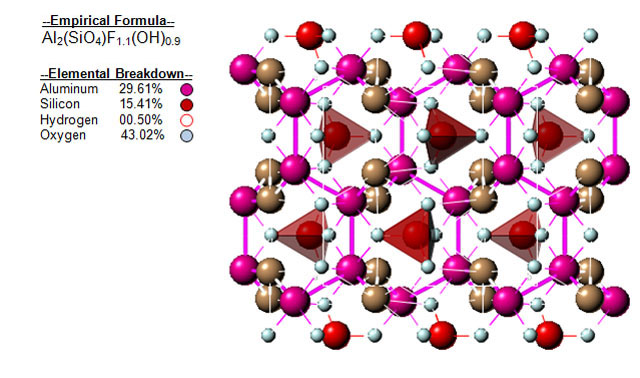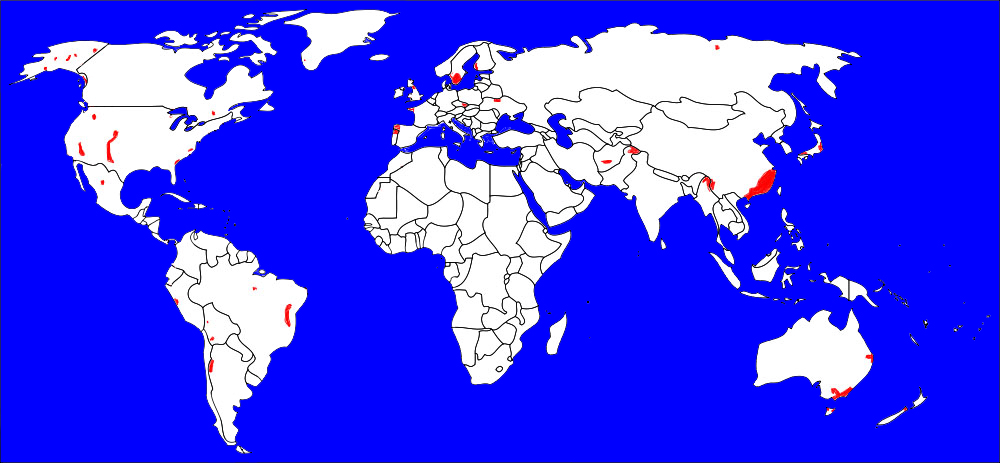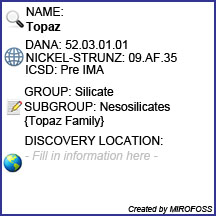

| Mineral Name | Topaz |
| First Discovered | Prehistoric, Exact Year Unknown |
| Nickel-Strunz Classification | 09.AF.35 |
| Dana Classification | 52.03.01.01 |
| ICSD | Pre IMA |
| Mineral Group | Silicates |


| Cleavage | Perfect |
| Colour(s) | Colourless, Pale blue, Yellow, Yellowish brown, Red |
| Specific Gravity | 3.55 |
| Diaphaneity | Transparent |
| Fracture | Brittle - Uneven - Very brittle fracture producing uneven fragments |
| Mohs Hardness | 8.0 |
| Luminescence | Fluorescent, Short UV - golden yellow, Long UV - cream |
| Luster | Vitreous |
| Streak | White |
| Habit(s) | Crystalline to Massive to Prismatic |
| Radioactivity | Non-radioactive |
| Magnetism | Non-magnetic |

No known health risks have been associated with topaz. However ingestion of topaz, as with other naturally occurring minerals, is not recommended.

The following image shows the elemental breakdown of the mineral topaz along with the mineral crystal structure.


| Crystal System | Orthorhombic |  |
| Class | Dipyramidal | |
| Axial Ratios | a : b : c = 0.528 : 1 : 0.955 | |
| Morphology | Long to short prismatic | |
| Optical Data Type | Biaxial (+) | |
| Pleochroism (x) | Colourless | |
| Pleochroism (y) | Colourless | |
| RL Values | nα = 1.606 - 1.629 nβ = 1.609 - 1.631 nγ = 1.616 - 1.638 | |
| 2V | Measured: 48° to 68°, Calculated: 58° to 68° |  |
| Max Birefringence | δ = 0.010 (See colour chart at right) | |
| Surface Relief | Moderate | |
| Dispersion | Noticable r > v | |
| Notes | Weak pleochroism can be observed in thin sections of topaz. | |

Topaz can be referenced in certain current and historical texts under the following six names:
The mineral topaz can be translated into the following select languages:
| Arabic | زبرجد | Bulgarian | Топаз | Chinese (Sim) | 黄玉 |
| Croatian | Topaz | Czech | Topaz | Danish | Topas |
| Dutch | Topaas | Esperanto | Topaz | Estonian | Topaas |
| Finnish | Topaasi | French | Topaze | German | Topas |
| Greek | ουσ. τοπάζι | Hebrew | טופז | Hungarian | Topáz |
| Italian | Topazio | Japanese | トパーズ | Korean | 황옥 |
| Latin | Chrysolithus | Lithuanian | Topazas | Norwegian | Topas |
| Persian | زبرجد هندی | Polish | Topaz | Portuguese | Topázio |
| Romanian | Topaz | Russian | Топаз | Slovak | Topás |
| Spanish | Topacio | Swedish | Topas | Tagalog | Topasiyo |
| Turkish | Topaz | Ukrainian | Топаз | Vietnamese | hoàng ngọc |

Topaz can be found in many places around the world. The map below shows major documented concentrations of topaz:


 |
The MIROFOSS database offers free printable geological identification tags for personal and non-profit use. These tags can be used to properly identify mineral samples in your collection. -Click here- to download a full size jpeg image for a topaz identification tag; which can be printed on paper or used with a plastic laser printer. |
 |
What's this? What can I do with it? |

| Chemical Composition | Wunder B , Rubie D C , Ross C R , Medenbach O , Seifert F , Schreyer W , American Mineralogist , 78 (1993) p.285-297, Synthesis, stability, and properties of Al2SiO4(OH)2: A fully hydrated, analogue of topaz |
| Crystallography | E. E. Foord, L. L. Jackson, J. E. Taggart, J. G. Crock & T. V. V. King (1995): Topaz: environment of crystallization, crystal chemistry, and infrared spectra. Mineralogical Record, 26, 69–71. |
| History | Hurlbut, Cornelius S.; Klein, Cornelis, 1985, Manual of Mineralogy, 20th ed., ISBN 0-471-80580-7 |
| History | Famous and Notheworthy Topazes Rao Bahadur, A Handbook of Precious Stones, Geological Survey of India |
| Geographical Data | Mindat.org. Retrieved on 2012-01-05 |
| Physical Identification | Webmineral.com. Retrieved on 2012-01-05. |
| January 9, 2012 | The last time this page was updated |
| ©2017 MIROFOSS™ Foundation | |
 |